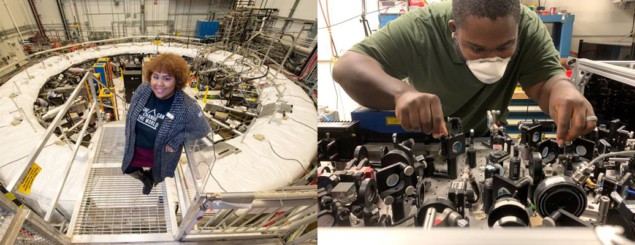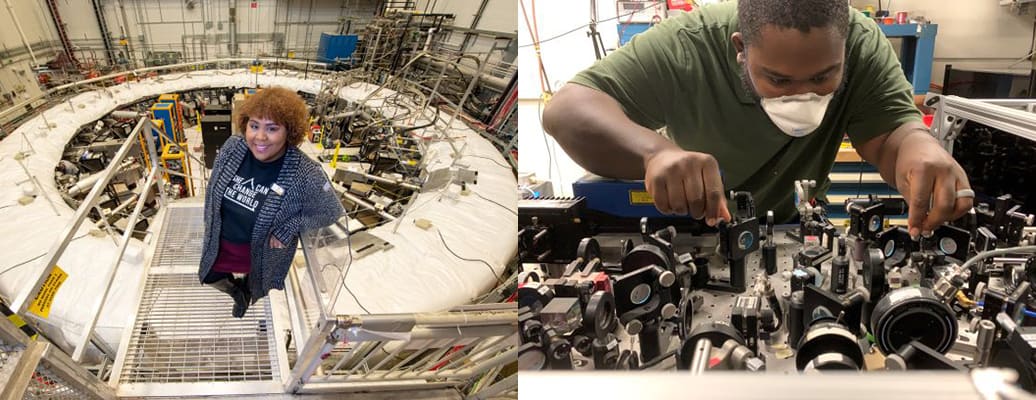This article is the seventh in a series of essays written by Black physicists and co-published with Physics Today as part of #BlackInPhysics week, an event dedicated to celebrating Black physicists and their contributions to the scientific community, and to revealing a more complete picture of what a physicist looks like.
 JE) at the ass crack of dawn. Bleary-eyed and annoyed, I roll over to dismiss it for the fifth time and do my morning doom scroll of social media before convincing myself that I do, in fact, need to attend my morning Zoom call. I’ve been working from home for seven months, and the commute is great: my office is in my kitchen, 10 steps from my bed (yes, I counted). Still, amid the pandemic; the police killings of Black people followed by no justice; and the death of my dad in June, I find getting up to work difficult. As I’m brushing my teeth, I see dark circles under my eyes, and my springy curls – thinning from the stress, sadness and anxiety – jut out in all directions like a dented crown. I splash some water on my face and tell myself that this is going to have to do, but as I scroll to find the Zoom link, I see a pile of dishes in the sink behind me, papers strewn across the counter and groceries that we were just too tired to put away last night. I need a Zoom background, but the one I carefully picked from West Elm’s site to mimic my dream kitchen can’t figure out how to position itself around my curls. Even in the COVID-19 era of virtual meetings, I’m subliminally told that I don’t belong.
JE) at the ass crack of dawn. Bleary-eyed and annoyed, I roll over to dismiss it for the fifth time and do my morning doom scroll of social media before convincing myself that I do, in fact, need to attend my morning Zoom call. I’ve been working from home for seven months, and the commute is great: my office is in my kitchen, 10 steps from my bed (yes, I counted). Still, amid the pandemic; the police killings of Black people followed by no justice; and the death of my dad in June, I find getting up to work difficult. As I’m brushing my teeth, I see dark circles under my eyes, and my springy curls – thinning from the stress, sadness and anxiety – jut out in all directions like a dented crown. I splash some water on my face and tell myself that this is going to have to do, but as I scroll to find the Zoom link, I see a pile of dishes in the sink behind me, papers strewn across the counter and groceries that we were just too tired to put away last night. I need a Zoom background, but the one I carefully picked from West Elm’s site to mimic my dream kitchen can’t figure out how to position itself around my curls. Even in the COVID-19 era of virtual meetings, I’m subliminally told that I don’t belong.
While a failed Zoom background is a relatively trivial problem, the lack of representation of Black individuals in artificial intelligence (AI) has major consequences. AI systems are designed to mimic human intelligence, and they have taken hold of our lives, from the targeted ads we see when we are online shopping to the “recommended” section on a Netflix home page. While these systems offer significant societal benefits, too many of them have detrimental effects on the Black community. We can joke about automated soap dispensers being “racist” – their infrared technology cannot recognize darker complexions – but the same technology is also used in pulse oximeters. Here, encoded racial bias could mean life or death for Black individuals, especially in the time of COVID-19 when monitoring oxygen levels is important.
Google searches are also powered by AI, and even apparently innocuous searches can have noxious side-effects. As the writer and communications expert Safiya Umoja Noble details in her essay “The enduring anti-Black racism of Google search”, over-sexualization of Black girls is widespread, as is the idea that naturally textured Black women’s hair is somehow “unprofessional”. While some may think these errors have been fixed, in June 2020 the Google Ad portal was still perpetuating the objectification of Black girls, and in July the Massachusetts Institute of Technology permanently pulled a widely used, 80-million-image AI dataset because so many of the images were labelled in racist and misogynistic ways. These datasets are used to train image-recognition software that feeds into technology such as self-driving cars, social media and facial-recognition software used by police.
The role of physicists in AI
My graduate work in particle physics focused on developing a form of AI called a convolutional neural network that can distinguish charged-current muon–neutrino interactions from neutral-current interactions at low energies. Before my work, these interactions were seen as essentially identical. My motivation for developing this algorithm was to suss out a very complicated signal in the mounds of data the MicroBooNE detector at Fermilab creates, but historically, basic research also motivates innovations and new technology. The fact that my research, my proximity to AI, could have detrimental effects on the Black community is discombobulating.
Physicists like me who study such abstract concepts don’t tend to dwell on how our research might work its way into society. However, I’ve come to realize that we can’t just bury our heads in the sand. We cannot develop AI because we want to find physics beyond the Standard Model without also recognizing that some aspects of our innovations could be used to harm the Black community. Black scientists need to be in the room when AI algorithms are developed, and as a physics community, we need to be discussing the ethics of our role in that work.
The coming quantum revolution
Like AI, quantum information science and engineering (QISE) is a rapidly evolving field with tremendous potential benefits. Quantum mechanics describes the laws of physics at microscopic length scales, and QISE researchers like me (CB) endeavour to control the systems that obey these fundamental laws. By doing so, we hope to engineer novel quantum devices such as quantum sensors, networks or computers, as well as novel quantum materials with properties that don’t exist at everyday length scales.
What makes a quantum sensor, computer or network unique is its reliance on quantum superposition. Superposition allows the bits in a quantum computer – qubits – to encode much more information than classical bits. This should help researchers solve some currently intractable problems, while quantum networks should enable fast and secure information transfer between quantum devices. Superpositions are also prone to collapse when measured, meaning that, in principle, if an eavesdropper tried to intercept information encoded in a superposition, their spying would be immediately detectable. It is precisely this sensitivity to measurement, or perturbation, that enables researchers to create quantum sensors that are far more sensitive than classical ones.

Taking responsibility: the ethics of being Black in physics
QISE could revolutionize our technology and understanding of nature, and it is important for Black physicists to have a stake in that revolution. Yet I have been part of the QISE world for nearly a decade, and throughout its rise I have rarely seen other Black physicists. Fellow QISE researchers (and all physicists): who do you see in your Gordon Research Conference photograph? Who is in the bustling hallways and jam-packed QISE sessions at the APS March Meeting, or in the massive banquet room at the APS DAMOP meeting? If you can only remember a few (or zero) Black physicists, that is not surprising: in 2017 Black students were awarded about 3% of physics undergraduate degrees and 2% of physics PhDs in the US, according to data from the National Center for Education Statistics.
Representation matters
The low number of Black physicists, particularly in QISE, presents several issues that must be addressed. First, representation matters. It’s important that future or younger Black physicists are empowered by established, visible Black physicists making an impact in QISE. Second, early-career doctorate holders (those who have held a PhD for 10 years or fewer) bring new skills and knowledge to the STEM workforce, and are considered important drivers of technological progress and knowledge generation – but few of us are Black (figure 1), and Black representation is low throughout science and engineering occupations (figure 2).
The $100m IBM-HBCU Quantum Center is a good example of the ongoing effort required to change this unsatisfactory status quo. The centre was set up as a partnership between IBM and historically Black colleges and universities (HBCUs) in the US, and it aims to help HBCU students and faculty get involved in QISE in a way that promotes belonging. The centre will also provide research opportunities to (under)graduates and connect HBCU talent to the QISE community. In doing so, it will have a direct and positive impact on Black representation in QISE, both in academia and in industry.
The money pouring into QISE offers many other opportunities to increase Black representation. The US National Science Foundation (NSF) recently created three $25m Quantum Leap Challenge Institutes that aim to advance the state of the art in quantum sensing, networking and computation. Another NSF-funded centre, Quantum Foundry, is designed to do the same for quantum materials. The US Department of Energy recently created the $115m Quantum Systems Accelerator to advance technological solutions to problems in QISE. The quantum technological revolution these institutions help to bring about will be transformative for science and society, and there is an incredible opportunity here to ensure that Black students are included in the research and training they offer, and to give established Black physicists the financial and infrastructural resources they need to participate.
A call for action
We both dream of a “quantum leap” in Black representation in physics, and the bountiful funding for both AI and QISE research places existing and future research centres in a unique position to help bring that about. If these centres implement swift action to develop and include Black researchers – perhaps by adopting the goals of the IBM-HBCU Quantum Center – then the researchers they support will be positioned to make important contributions to these developing fields.
In AI and QISE, especially, the richness of experience that Black physicists bring to research teams improves problem solving and provides a much-needed perspective on how technologies should be implemented. Without a concerted effort to address the current under-representation, however, the scientific community risks missing out on this perspective, perpetuating harm to the Black community, and unjustly excluding Black people from technologies that will wholly transform society.
